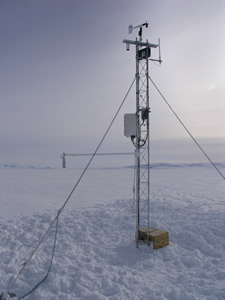The History of Antarctic Meteorology Research at the University of Wisconsin-Madison
Establishing Antarctic research at UW-Madison
In the 1960s, Professor Werner Schwerdtfeger played a large role in establishing Antarctic meteorological research at the University of Wisconsin-Madison (UW-Madison). Schwerdtfeger was already a well-known Antarctic researcher before arriving at UW-Madison in 1963, utilizing the sparse observations in the region to study Antarctic meteorology. His studies, along with those of Professor Heinz Lettau, illustrated the need for additional observations throughout the Antarctic.
Developing an Automatic Weather Station
The development of an autonomous, automated weather station had been attempted in the United States Antarctic Research Program (later shortened to United States Antarctic Program or USAP) since the International Geophysical Year (IGY). In 1978, Professor Alan Peterson at the Radio Science Laboratory at Stanford University developed the forerunner to the modern Antarctic Automatic Weather Station (AWS). Key stages that led to this initial success were the development of low power integrated circuits and the Data Collection System (DCS) or Argos satellite communication system that allowed for the observational data from the AWS to be recorded on polar orbiting weather satellites and transmitted back to mid-latitude reception stations for analysis.
Antarctic Automatic Weather Station Project
In 1979, Schwerdtfeger introduced the Antarctic to a colleague at UW-Madison, Professor Charles Stearns. Stearns was already very actively developing and setting up instrumentation for meteorological experiments in Wisconsin and other locations. Stearns’ experience and efforts with AWS led to the installation of weather stations around the Antarctic, with 1980-81 being the inaugural field season of what is now regarded as the UW-Madison AWS Program.

The UW-Madison AWS Network has expanded throughout the years to include observing in numerous regions of Antarctica including the Ross Ice Shelf, West Antarctica, the Antarctic Peninsula, the South Pole, and the East Antarctic Plateau. The data have been used in a variety of research efforts including boundary layer meteorology experiments near the South Pole, Katabatic Wind studies in a variety of locations including Reeves Glacier and the Adelie Coast, the Long Term Ecological Research project along the Antarctic Peninsula, and Barrier wind flow studies along the Transantarctic Mountains and the Antarctic Peninsula, as well as flight forecasting and long term climatology studies of key locations such as Dome C in East Antarctica and historic Byrd Station in West Antarctica.